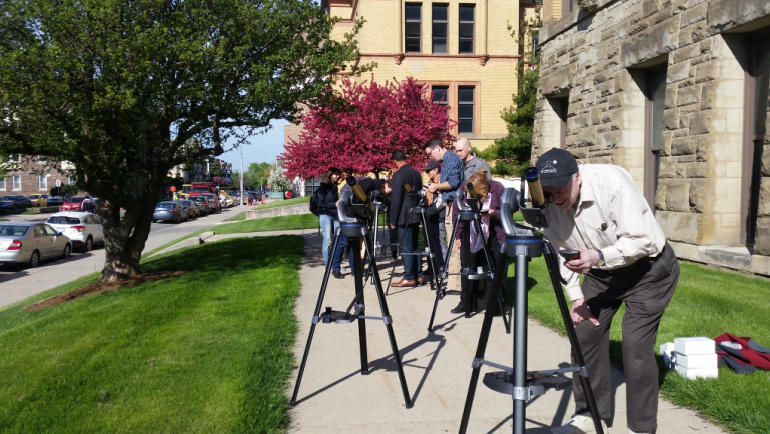
A near-total solar eclipse will occur on Monday, April 8. This is a rare opportunity to experience almost all the light from the sun being blocked out by the moon. Excitement about the event is building, including among the (out of this) world class faculty at Wayne State University’s Department of Physics and Astronomy.
The maximum eclipse will be at 3:14 p.m. in Detroit, with the partial eclipse starting at 1:58 p.m. and continuing until 4:27 p.m. On Monday, the Department will have solar telescopes for the community to safely view the sun at the following locations:
- The "W" statue located at the intersection of 2nd and Warren Avenues
- In front of Old Main, located at 4841 Cass Ave
- The fountain on Gullen Mall

Department Chair and Professor Ed Cackett, whose research focus areas include neutron stars and black holes and has been celebrated in Nature and by NASA and the European Space Agency (ESA), encourages everyone to experience this rare event. Cackett notes that the last total solar eclipse in the contigous U.S. was in 2017, and the next one won't be until 2044; it won't occur again in Michigan until 2099.
Cackett emphasizes that no one should ever look directly at the sun, and describes how to safely view this extraordinary celestial event:
What to know ahead of the eclipse
-
Detroit is just outside the path of totality of the eclipse, and will experience a 99.5% eclipse — only a tiny sliver of the sun will remain uncovered. If you want to experience the full totality, you will need to drive about an hour south to Toledo, Ohio, or anywhere else along the path. NASA provides a nice map you can explore.
- Several things will happen as totality approaches: The sky darkens, the temperature drops, birds take notice and go quiet, shadows go fuzzy and some will even show the shape of the crescent sun. When it reaches totality, the sun’s atmosphere, which is usually invisible to us, will appear. First, you see an effect called the "diamond ring" as the last glint from the sun shines like a diamond. Then, the sun’s outer atmosphere, or corona, lights up. You can see the stars in the daytime sky. While totality only lasts a couple of minutes, it is breathtaking. It is well worth the effort to go see it.
- Keep an eye on the weather. To see the eclipse, a clear view of the sun without clouds is necessary. Even if it is cloudy, the sky will get noticeably darker.
Tips for watching the eclipse
- Get a pair of eclipse glasses. The Wayne State Planetarium has eclipse glasses available at their shows on Friday, April 5 at 6 p.m. and 7:30 p.m. There is also a film showing at 12:30 p.m. on Wednesday, April 3. The eclipse glasses are available for a minimum $1 (cash only) donation for each pair of glasses (maximum 10 pairs per patron). Please note that planetarium doors are closed during events and our hosts are busy with the show, so glasses are only available immediately before and after the events. If you are looking to get glasses but cannot join for a show, we recommend you visit the Michigan Science Center gift shop which has $2 glasses and is open to the public 10 a.m. - 4 p.m. Tuesday-Sunday. You do not need to pay museum admission to visit the Science Center gift shop.
- Make a pinhole camera! Use a sharp point to prick a small hole through a piece of paper or a card. Hold this a few feet away from the ground and it will project an image of the sun. You will need to move it closer or further away from the ground to get the best-projected image.
- Use a colander: These already have holes in them! Hold it a few feet from the ground and you should see an image of the eclipse from every hole projected onto the ground.
- Use your hands: Overlay your fingers in a crisscross pattern with small holes between them. Again, hold a few feet away from the ground. Move your fingers closer together or further apart to get the best image. The image will be projected onto the ground.
- Look at the shadows around you from trees. As light passes through leaves or cross branches it will make crescent eclipse patterns in the shadows on the ground.
